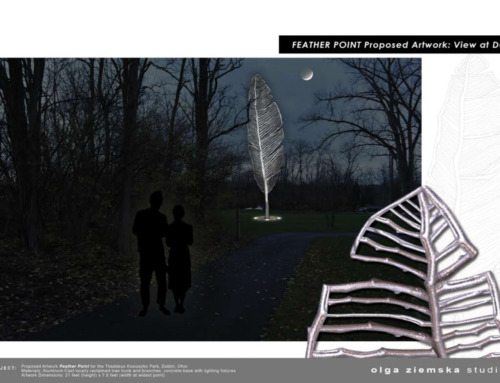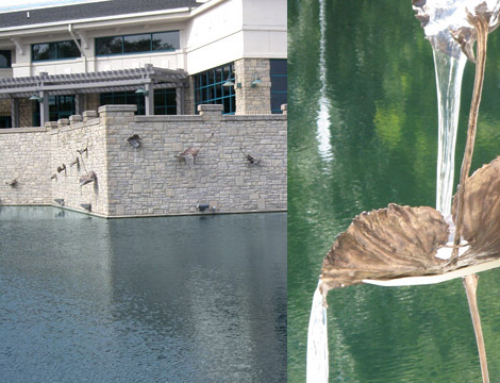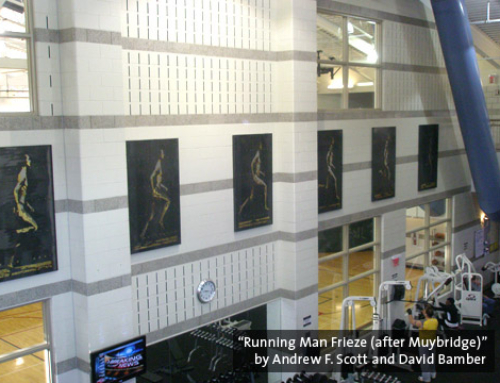artist: Mike Tizzano
date commissioned: 2012
location: Historic Dublin
address: Corner of Bridge and High streets
Cell Tour: 614-368-6999, stop 18
The Daily Chores sculpture was inspired by Dublin’s historic town water pump that sat in the middle of the intersection of what is now Bridge and High streets in the early 1900s. While the pump was a primary source of drinking water for the town, it was also a community gathering place where residents would come together to share news and connect with one another.
In 2012, artist Michael Tizzano was commissioned by the City of Dublin to create a figurative bronze and stone sculpture to commemorate the historic town pump. The sculpture was created by the artist on view at the Dublin Community Recreation Center, encouraging community education and public engagement over an eight-month time period. The representative figures were inspired by a collection of poses and attributes of various Dublin school children.
After intensive labor, the life-size sculpture has been transported to the foundry for the final steps of the bronze sculpture process. The last stage of the process concluded at the foundry with the creation of a rubber mold of the sculpture for the bronze pour and casting process.
The Daily Chores sculpture, at the corner of Bridge and High streets, was dedicated to the community in the spring of 2014.


The town pump, circa 1920
The historic town pump
Over a century ago, residents would venture to the center of town with a water pail in hand to retrieve their drinking water from Dublin’s main pump. Sitting in the middle of the intersection of Bridge and High streets, the town pump was surrounded by a 22-inch concrete barrier and had a horse trough at one end. With the advent of motorcars, the pump soon became a hazard due to its location in the middle of the road.
The State Highway Department offered to move the pump out of the intersection to keep it out of harm’s way, but there was disagreement on its new placement. The demise of the main town water pump took place after a motorist slammed into the barrier that surrounded the pump and threatened to sue the village. The pump was eventually removed and replaced with a traffic light, as automobiles became more commonplace in the village.
About the artist
Michael Tizzano lives and works in his art studio in Westerville, Ohio. A former middle school art teacher of 23 years, Tizzano retired in 2010 to pursue sculpting full time. Throughout his tenure as a teacher, Tizzano worked as a freelance graphic designer specializing in lettering design for clients such as Mid-Ohio racing. He also completed post-graduate coursework in architecture, art history and bronze casting at The Ohio State University in 1993 and 1994. Tizzano has created numerous commissioned public and private sculptures for clients over the past 22 years, including ballet dancers for Dublin Dance Arts, Kayla Reading at Blendon Middle School media center, and The Chase for Westerville Parks and Recreation.
A keen observer of his surroundings, Tizzano draws his inspiration from the world around him. He works from multiple sources, including visual memory, photographs, drawings and sketches when creating a sculpture. Sculptures are three-dimensional works of art, so Tizzano created a ¼-scale model, called a maquette, to have a sense of the final work. For Daily Chores, Tizzano used historic photos of the pump at the intersection of Bridge and High streets along with current photographs and sketches of local children to create the initial maquette that served as a model for the full-scale sculpture.
Daily Chores tells the story of a different time through art. Featuring two barefoot children dressed in period clothing, the sculpture shows a six-year-old boy struggling to operate the pump while his 13-year-old sister sits on the edge of the horse trough, holding a pail to collect the water. As Tizzano describes the scene, “… she loses her focus and allows the pail to overflow, spilling its contents into the trough, creating the fountain feature.”
The video above shows the creative process, from maquette to clay. See if you can identify the steps, using the vocabulary below:
Sculpting terms
Armature wire: skeletal framework built as a support on which a clay, wax or plaster figure is constructed
Maquette: a smaller, three-dimensional model of a full-size sculpture that an artist plans to create
Plastilina: an oil-based modeling clay that never hardens or dries out.
Polystyrene foam: a lightweight but strong insulation foam that when rasped will form the proportions of the sculpture
Rasp: to scrape with a rough instrument



















